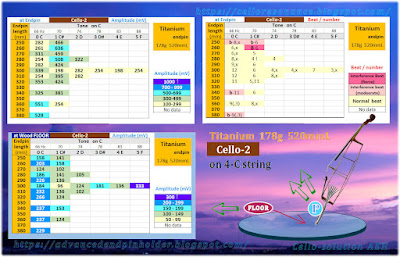[ 1/27/2022 ] Labels: 53.Endpin-Resonance3
(1) REVIEW-1: Cello tones :D#(78 Hz) to D(147 Hz) are presumed taking a two times '8'-shape-circling-orbit along the upper octave orbits. Actually, observing oscilloscope shows a typical two beats in a cycle period.
(2) REVIEW-2: The lowest tones: C(66Hz) to D(74Hz) has unfortunately a longer wavelength than the 'two-cycle-orbit'. If the cello is floating in the air, a very unique solution is adopted: Many upper overtone orbits are linked then makes an fundamental-tone-equivalent wavelength. The typical sample is the C(66Hz, wavelength=5.18m). Sometimes C(5.18m) is assembled as G(198Hz,1.73m)+C(263Hz,1.30m)+E(331Hz,1.04m)x2. Wave-synthesis simulation results sometimes well match to the real sound waveform. C(131Hz) never participates as a candidate because the actual C(131Hz) orbit does not exist in the cello body.
(3) When a cello placed on the floor, actual oscilloscope study indicates A)fading overtone assemblage in sound and B)remarkable interference beats on endpins. In many cases the interference beats are cast as a synthesis of two original different frequency. The ratio was usually 1.1 or 1.2, for instance, 5.18m(C66Hz) vs 5.18m + 'endpin length(0.5m)' x2 can make the ratio as 1.2. The real orbit/route in a cello seems prior to the virtual orbits inside the cello body. Endpins are now a part in cello. Usually, endpins do not create a real sound but sometimes generates an unpleasant interference beats at the endpin, then the beats sometimes fiercely impact on the floor
(1) 復習-1: D#(156Hz)よりも低トーンでは筐体内でどのように共鳴しているかと言えば、上側の1オクターブで取っている8の字軌道を2周していると考えられる。実際に音波形を調べると基本的に"2ビート"であることから解る。
(2) 復習-2: 最低音C(66Hz)-D(74Hz)では、そのトーン波長が8の字を2周しても筐体内に収まらない。エンドピン無しで空中で演奏される時、チェロはその解決策として上方の(高音)倍音を複数組み合わせてバーチャル軌道を採用しているように見える。ちなみに、C(66Hz)の場合、例えば、G(197Hz) + C(263Hz) + E(331Hz)x2 = C(66Gz,5.18m波長と同じ長さとなる) を取ることが多いようだ。波の合成シミュレーション波形とよく一致する。ここで、C(131Hz)倍音は含まれない。なぜならこの軌道は成立しないから。
(3) エンドピン付きで床置きした場合はどうであろうか。観察してみると筐体から放出される(倍音)バーチャル軌道波形(,音)の比率は低下し、代わってエンドピンの顕著な機械振動が目につくようになる。エンドピンに激しいうなりを伴う干渉波形が見られる場合が多い。シミュレーションによれば、8の字x2周 + エンドピン全長x2(=1.2) と 8の字x2周(=1.0) の波長がエンドピンで干渉していると推定される。つまり、余った波長長さがエンドピン往復(1回)の距離を使って帳尻を合わせている形である。バーチャル軌道よりもリアル軌道が優先され、エンドピンが楽器の一部になっていることを意味している。エンドピンは振動しても音はほとんど生成しない。その干渉波は条件がそろうと、与えられる周期に呼応してエアハンマーのように床に伝わることになる。これが床を揺らすチェロの低音の一因であると考えられる。













